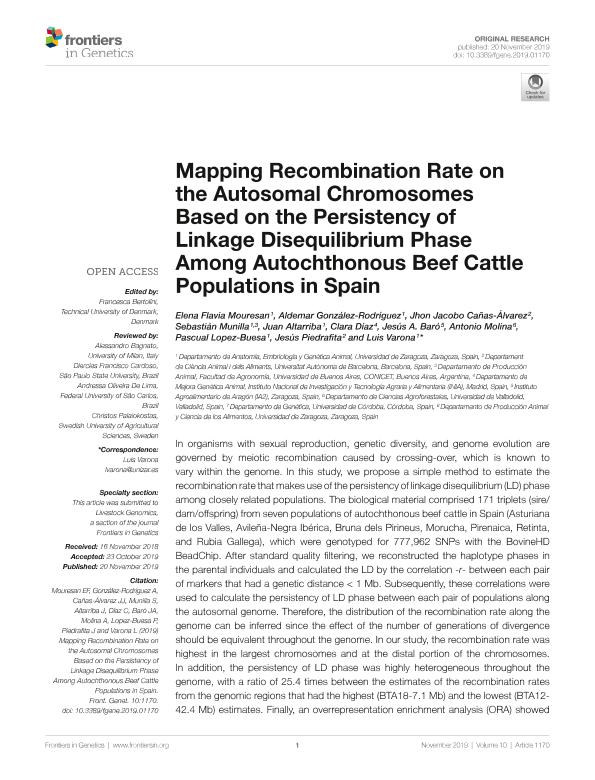Mostrar el registro sencillo del ítem
dc.contributor.author
Mouresan, Elena Flavia
dc.contributor.author
González Rodríguez, Aldemar
dc.contributor.author
Cañas Álvarez, Jhon Jacobo
dc.contributor.author
Munilla Leguizamon, Sebastian

dc.contributor.author
Altarriba, Juan
dc.contributor.author
Díaz, Clara
dc.contributor.author
Baró, Jesús A.
dc.contributor.author
Molina, Antonio
dc.contributor.author
Lopez-Buesa, Pascual
dc.contributor.author
Piedrafita, Jesús
dc.contributor.author
Varona, Luis
dc.date.available
2021-03-19T17:48:54Z
dc.date.issued
2019-11-20
dc.identifier.citation
Mouresan, Elena Flavia; González Rodríguez, Aldemar; Cañas Álvarez, Jhon Jacobo; Munilla Leguizamon, Sebastian; Altarriba, Juan; et al.; Mapping recombination rate on the autosomal chromosomes based on the persistency of linkage disequilibrium phase among autochthonous beef cattle populations in Spain; Frontiers Media S.A.; Frontiers in Genetics; 10; 1170; 20-11-2019; 1-12
dc.identifier.uri
http://hdl.handle.net/11336/128670
dc.description.abstract
In organisms with sexual reproduction, genetic diversity, and genome evolution are governed by meiotic recombination caused by crossing-over, which is known to vary within the genome. In this study, we propose a simple method to estimate the recombination rate that makes use of the persistency of linkage disequilibrium (LD) phase among closely related populations. The biological material comprised 171 triplets (sire/dam/offspring) from seven populations of autochthonous beef cattle in Spain (Asturiana de los Valles, Avileña-Negra Ibérica, Bruna dels Pirineus, Morucha, Pirenaica, Retinta, and Rubia Gallega), which were genotyped for 777,962 SNPs with the BovineHD BeadChip. After standard quality filtering, we reconstructed the haplotype phases in the parental individuals and calculated the LD by the correlation -r- between each pair of markers that had a genetic distance < 1 Mb. Subsequently, these correlations were used to calculate the persistency of LD phase between each pair of populations along the autosomal genome. Therefore, the distribution of the recombination rate along the genome can be inferred since the effect of the number of generations of divergence should be equivalent throughout the genome. In our study, the recombination rate was highest in the largest chromosomes and at the distal portion of the chromosomes. In addition, the persistency of LD phase was highly heterogeneous throughout the genome, with a ratio of 25.4 times between the estimates of the recombination rates from the genomic regions that had the highest (BTA18-7.1 Mb) and the lowest (BTA12-42.4 Mb) estimates. Finally, an overrepresentation enrichment analysis (ORA) showed differences in the enriched gene ontology (GO) terms between the genes located in the genomic regions with estimates of the recombination rate over (or below) the 95th (or 5th) percentile throughout the autosomal genome.
dc.format
application/pdf
dc.language.iso
eng
dc.publisher
Frontiers Media S.A.

dc.rights
info:eu-repo/semantics/openAccess
dc.rights.uri
https://creativecommons.org/licenses/by/2.5/ar/
dc.subject
BEEF CATTLE
dc.subject
GENE ONTOLOGY
dc.subject
LINKAGE DISEQUILIBRIUM
dc.subject
MULTIPLE POPULATIONS
dc.subject
RECOMBINATION RATE
dc.subject.classification
Otras Producción Animal y Lechería

dc.subject.classification
Producción Animal y Lechería

dc.subject.classification
CIENCIAS AGRÍCOLAS

dc.title
Mapping recombination rate on the autosomal chromosomes based on the persistency of linkage disequilibrium phase among autochthonous beef cattle populations in Spain
dc.type
info:eu-repo/semantics/article
dc.type
info:ar-repo/semantics/artículo
dc.type
info:eu-repo/semantics/publishedVersion
dc.date.updated
2021-03-05T18:50:44Z
dc.identifier.eissn
1664-8021
dc.journal.volume
10
dc.journal.number
1170
dc.journal.pagination
1-12
dc.journal.pais
Estados Unidos

dc.description.fil
Fil: Mouresan, Elena Flavia. Universidad de Zaragoza; España
dc.description.fil
Fil: González Rodríguez, Aldemar. Universidad de Zaragoza; España
dc.description.fil
Fil: Cañas Álvarez, Jhon Jacobo. Universitat Autònoma de Barcelona; España
dc.description.fil
Fil: Munilla Leguizamon, Sebastian. Universidad de Zaragoza; España. Universidad de Buenos Aires. Facultad de Agronomía. Departamento de Producción Animal; Argentina. Consejo Nacional de Investigaciones Científicas y Técnicas. Oficina de Coordinación Administrativa Parque Centenario; Argentina
dc.description.fil
Fil: Altarriba, Juan. Universidad de Zaragoza; España
dc.description.fil
Fil: Díaz, Clara. Instituto Nacional de Investigación y Tecnología Agraria y Alimentaria; España
dc.description.fil
Fil: Baró, Jesús A.. Instituto Agroalimentario de Aragón; España
dc.description.fil
Fil: Molina, Antonio. Universidad de Valladolid; España
dc.description.fil
Fil: Lopez-Buesa, Pascual. Universidad de Zaragoza; España
dc.description.fil
Fil: Piedrafita, Jesús. Universitat Autònoma de Barcelona; España
dc.description.fil
Fil: Varona, Luis. Universidad de Zaragoza; España
dc.journal.title
Frontiers in Genetics
dc.relation.alternativeid
info:eu-repo/semantics/altIdentifier/doi/http://dx.doi.org/10.3389/fgene.2019.01170
dc.relation.alternativeid
info:eu-repo/semantics/altIdentifier/url/https://www.frontiersin.org/articles/10.3389/fgene.2019.01170/full
dc.relation.alternativeid
info:eu-repo/semantics/altIdentifier/url/https://www.ncbi.nlm.nih.gov/pmc/articles/PMC6880760/
dc.relation.alternativeid
info:eu-repo/semantics/altIdentifier/url/https://pubmed.ncbi.nlm.nih.gov/31824571/
Archivos asociados
